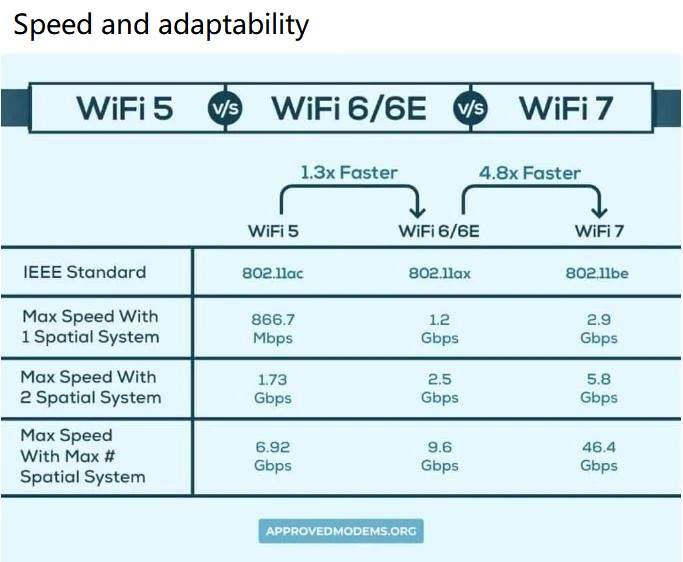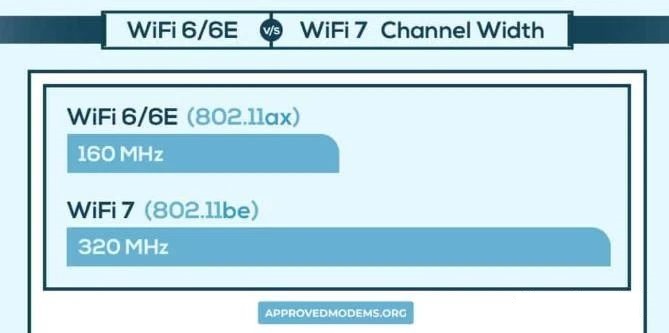
If you are an internet enthusiast and want to learn the difference between WiFi 6, 6E, and the heavily promoted latest Wi Fi 7, then you have come to the right place. Let's compare all three wireless standards to understand their differences and how they translate into real-life performance.
The main features of Wi Fi 6 and 6E are the same, except that 6E has added a 6 GHz frequency band, which helps to easily navigate crowded networks. The next generation Wi Fi 7 will double its bandwidth and triple its throughput.
Due to its excellent amplitude modulation and double the number of spatial streams, Wi Fi 7 will make your wireless experience comparable to wired experience. how? Let's find the answer!
WiFi 6 vs 6E vs 7:Technical differences
| Aspect | Wireless Network 6 | WiFi 6E | Wireless Network 7 |
| IEEEStandard | 802.11ax | 802.11ax | 802.11be |
| Speed capacity | 9.6Gbps | 9.6Gbps | 30Gbps |
| Frequency band | 2.4GHz 和 5GHz | 2.4GHz、5GHz、6GHz | 2.4GHz、5GHz、6GHz |
| QAM modulation | 1024-QAM | 1024-QAM | 4096-QAM |
| Channel width | 160MHz | 160MHz | 320MHz |
| breakthrough point | Single | Single | Multiple types |
| Spatial flow | 8 of them | 8 of them | 16 |
| WiFi Security | WPA 3 | WPA 3 | WPA 4(undetermined) |
Introduction to WiFi 6, 6E, and WiFi 7
Are you already familiar with these wireless standards? Directly enter the detailed comparison between Wi Fi 6, 6E, and Wi Fi 7.
What is WiFi 6?
Wi Fi 6 was announced in 2019, achieving significant improvements through the introduction of ODFMA, power consumption improvements, and bidirectional MU-MIMO. Operating at frequencies of 2.4 and 5 GHz, there is a noticeable throughput increase of over 30% in efficiency compared to the previous generation.
What is WiFi 6E?
As an extension of Wi Fi 6, 6E was released in 2020, extending all features to the third frequency band of 6 GHz.
OFDMA、 The target wake-up time and low latency operating in three simultaneous frequency bands have become significant advantages in improving the area per square foot, especially in highly crowded environments.
With the launch of the 6E wireless standard, network companies have implemented 6GHz frequency band network equipment. You can find my first choice here.
What is WiFi 7?
The latest WiFi technology, Wi Fi 7, will be adopted in 2024 and has undergone significant revisions since its initial draft in 2021. 802.11be, also known as WiFi 7, doubles the bandwidth and has a channel frequency of 320Hz. With a four fold increase in QAM and an increase in spatial flow, the speed throughput reaches 30 Gbps, while operating on all three frequency bands of 2.4, 5, and 6 GHz.
WiFi 6 vs WiFi 6E vs WiFi 7: Detailed Comparison
In this section, I will compare WiFi 6 and 6E with WiFi 7 on several important factors.

When comparing WiFi 6 and 6E in terms of speed capability, they seem to provide a throughput of 9.6 Gbps, which is a huge leap compared to the speed provided by the Wi Fi 5 standard, which has an upper limit of 6.9 Gbps. Learn more.
To leverage the efficiency of the 6th generation wireless standards, you need OEMs to integrate them into the latest client devices, such as smartphones, tablets, game consoles, etc.
The upcoming WiFi 7 standard has tripled the theoretical speed capacity, reaching up to 30 Gbps. WiFi 7 speed will require a new manufacturing standard that includes high-performance gadgets and IoT devices designed to operate on multiple frequencies.
Frequency band
Wi Fi 6 operates on two main frequencies, 2.4 GHz and 5 GHz. With the increase of wireless devices, both frequencies have become crowded.
Wi Fi 6E extends all operational efficiency to an additional 6 GHz frequency band to avoid network interference and congestion issues.
Including the 6 GHz frequency band will increase the speed achieved in a shorter range. WiFi 7 operates on three frequency bands of 2.4 GHz, 5 GHz, and 6 GHz, similar to 6E, and has improved efficiency in other aspects.
This will enable the next generation WiFi technology to accommodate more gadgets and better performance in one area.
Channel width

Although the second wave of 802.11ac witnessed the use of a wider 80 MHz channel, a significant leap was achieved by introducing a 160 MHz channel in WiFi 6 routers.
The extended version of Wi Fi 6E is fully utilizing the advantage of a wider 160 MHz channel, which results in higher throughput for WiFi 6E routers.
As the release date of WiFi 7 approaches, there will be further improvements. The new generation of wireless devices will utilize a wider 320 MHz channel to achieve excellent efficiency and throughput levels.
QAM modulation
QAM modulation determines how data is packaged and transmitted on radio frequencies. The denser the modulation, the larger the amount of data that can be easily transmitted. The rise of high-quality 4K streaming and AR/VR content has tested the limits of Wi Fi 5 running on 256-QAM.
Wi Fi 6 and 6E propose higher modulation and operate with 1024-QAM. Wi Fi 7 goes further and achieves higher efficiency through more dense modulation of 4096-QAM. This effectively reflects throughput speed and makes higher speeds (such as 30 Gbps) possible.
data stream
The 6th generation wireless standard introduces bidirectional MU-MIMO into practical applications and doubles the number of spatial streams to 8, surpassing the 4 × 4 MU-MIMO of Wi Fi 5. This will allow up to eight simultaneous connections to access the Internet without losing speed and throughput.
Wi Fi 6 and 6E use bidirectional 8 x 8 MU-MIMO. WiFi 7 increases the number of spatial streams to 16. This will allow up to 16 devices to boot data at high speed.
The next generation of IoT devices will leverage the efficiency brought by the latest wireless technology.
Access point
In Wi Fi 6 and 6E, client devices can only use one frequency band at a time, which is 2.4/5/6 GHz. The intelligent connection function allows devices to automatically switch between these frequency bands based on signal quality and interference.
With Wi Fi 7, this is a brand new game. Introducing MLO (Multi Link Operation) allows client devices to send and receive data across different frequency bands and channels. This will minimize communication latency to a minimum. This gives you a wireless experience similar to wired Internet.
The reliability is significantly improved when using AR applications and online games.
WiFi Security
WiFi 6 and 6E have witnessed the excellent security encryption standard WPA 3, which uses a protected management framework and a 4-way handshake authentication protocol to ensure your connection is secure from any offline attacks that WPA2 is vulnerable to.
We don't expect WiFi 7 routers in another year. But when they enter the market, they may appear with the more advanced WPA4 encryption standard.
Is WiFi 6 suitable for playing games?
The speed provided by Wi Fi 6 standard is sufficient to provide an excellent gaming experience. However, if you want to switch to VR/AR based games, the additional 6 GHz band will be valuable for a reliable gaming experience.
Is Wi Fi 6 or 6E better?
Wi Fi 6E provides an additional frequency band with other advantages of the Wi Fi 6 standard. This gives it a huge advantage in avoiding network congestion and interference.
Will Wi Fi 7 have better coverage?
Indirectly, yes. The performance efficiency of Wi Fi 7 will directly affect signal quality. Extra frequency bands, wider channels, and double the number of spatial streams will result in better long-range performance.
How fast is Wi Fi 7?
Despite boasting theoretical speeds of up to 30 Gbps, achieving these speeds in practical environments will be challenging. However, the Internet throughput of personal client devices is expected to approach 5Gbps, more than twice the standard speed of Wi Fi 6.
conclusion
A router with Wi Fi 6 standard is sufficient to meet the needs of ordinary home users. Most of the client devices in use are Wi Fi 5, which will remain relevant for the foreseeable future. If you are in a smart home and have over 40 devices, choosing 6E makes more sense.
The speed of WiFi 7 is much higher than the speed available to home users, which makes it too large. It will be more suitable for commercial spaces and medium-sized offices.